
Its easier to stay motivated when you have a partner to work out with. Our partner exercises will get you and a buddy moving.
I love it when my husband wants to go to the gym on the weekends. This forces me to recognize that, though I may have planned to stay at home and clean bathrooms (and go to the gym later), he wants to go now and get it done.
|
Buddy workout benefits
|
This in turn forces me to reprioritize—because, let’s face it, the gym and my health shouldn’t be put on the back burner, while cleaning the toilet and the tub most certainly can.
Having a partner to work out with can be just the boost you need to maintain your fitness program, too. A workout buddy can motivate you, inspire you, and compete with you, which in turn will assist both of you in attaining your health and fitness goals.
So grab a friend or family member and make a commitment to each other. Commit to a healthier lifestyle and start the journey together one step at a time.
Take your first step with this workout that can be performed at home and requires minimal equipment, yet works every muscle in the body!
Instructions
Perform each movement for 10 to 20 repetitions, with no rest in between, with each partner getting in a set. Once you have completed all six movements, take a quick water break and perform again.
For beginners, start with two full cycles, working your way to four. Once you are able to complete the full four cycles, give the “turbo-charge” variations a try for a more challenging workout.
Remember, the body adapts quickly, so you must keep taxing it to increase not only your level of fitness but your partner’s level, too.
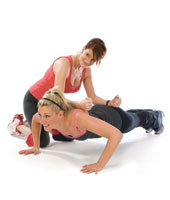 1. Push-ups
1. Push-ups
- With your partner on hands and knees (four-point), take a plank position with hands shoulder-width apart and resting on top of your partner’s back, arms extended.
- While you and your partner maintain a neutral spine and engage your deep abdominals (see vertical extensions exercise for the “sucker punch” approach), slowly come down into a push-up while your partner fights to maintain a four-point position.
Turbo-charge: To increase the intensity of this exercise, instead of kneeling on the floor in a four-point position, have your partner stand and hold onto your shins while you perform the push-ups. If this is too hard, bend your knees while your partner drops their legs closer to the ground.
2. Vertical extensions
This exercise requires a medicine ball (try a 6 lb/2.7 kg one if you are a beginner and up to a 12 lb/5.4 kg one if you are an advanced exerciser), and it’s not only a fantastic total-body exercise but also a great warmup for the rest of the program.
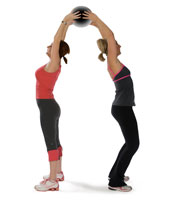

- Stand back to back with your partner, approximately 2 feet (60 cm) apart.
- Engage your core by pretending that someone is going to “sucker punch” you and you are bracing your abs waiting for the punch. Sounds violent, I know, but I find this cue works best to engage the deep abdominal muscles that are responsible for supporting
the spine. - Pass the medicine ball overhead to your partner, with straight arms, by extending the spine inward to reach behind you.
- Bend through the hips, maintaining a neutral spine, and get your partner to pass the ball back to you between the knees.
Turbo-charge: To boost the intensity of this exercise, increase your tempo (speed).
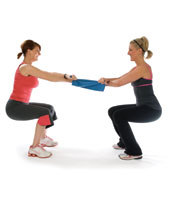 3. Squat
3. Squat
- Start by facing your partner, each of you holding onto the opposite ends of a small towel with both hands, criss-crossed.
- Slowly squat backward, keeping your kneecaps pointing forward. Avoid allowing your knees to collapse inward, and try to keep your weight distributed equally on all four corners of your feet.
- Lower until your upper thighs are parallel to the floor, hold for 2 seconds, and slowly extend back up.
Turbo-charge: To increase the intensity of this exercise, lift your left foot up off the ground, while your partner lifts their right foot up. Perform the squat one-legged, maintaining that 2-second pause at the bottom.
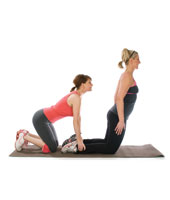 4. Hamstring push-offs
4. Hamstring push-offs
- Kneel on a mat in front of your partner.
- While your partner anchors your lower legs and ankles to the floor with their hands, slowly fall forward about 30 degrees.
- Ensure that your thighs and upper body stay in a straight line throughout the movement.
Turbo-charge: To increase the intensity of this exercise, go farther forward toward the floor.
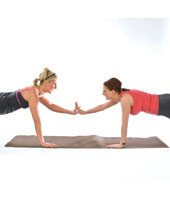 5. Plank with high-fives
5. Plank with high-fives
- Face the mat in a push-up position, with straight arms extended and balancing on your hands and toes, an arm’s-length away from your partner.
- While keeping backs flat, in a straight line from head to heels, tilt your pelvises and contract your abdominals to prevent your rear ends from sticking up in the air.
- Lift up your left hand while your partner lifts up their right.
- Give each other a high-five, alternating arms for 10 to 20 reps.
Turbo-charge: To increase the intensity of this exercise, as each of you lifts your arm up off the floor, lift up the opposite leg, too.
6. Reverse bent-knee plank/tricep dips
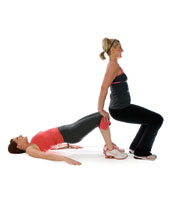
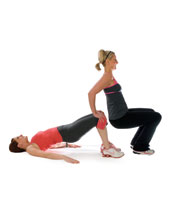
- Position yourself face up with your hands on the floor, fingertips facing your feet and your knees and hips bent at 90 degrees and feet flat on the floor. From there, lift up your hips so that your knees, hips, and shoulders are in line.
- While facing away from you, your partner adopts a tricep dip position with their knees bent and hands on top of each of your knees.
- While you maintain the reverse, bent-knee plank position, your partner slowly bends their elbows, performing a tricep dip.
Turbo-charge: To increase the intensity of this exercise, extend one leg while performing the dip.
How much is enough?
- Not sure how many repetitions to do, or how hard to go? Your last two or three reps should be hard, but still manageable with good form.
- Follow this general rule of thumb when working with body-weight exercises such as those prescribed in this workout.
- Beginners (new to exercise)—10 to 12 reps
- Intermediate (3 to 6 months of consistent exercising)—12 to 15 reps
- Advanced (6+ months consistent exercising)—15 to 20 reps




































